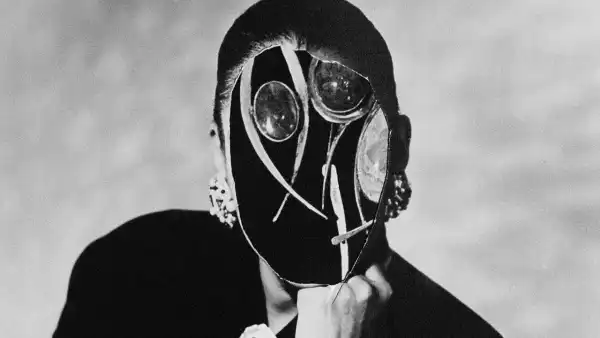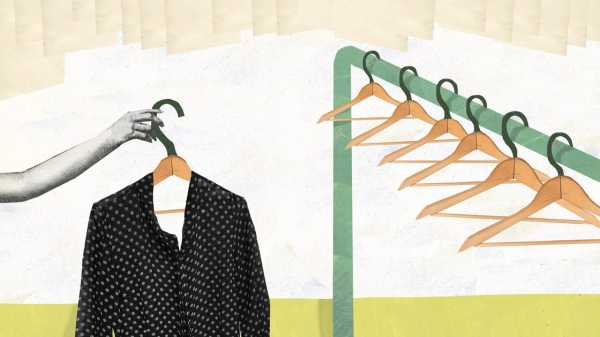
I don’t remember acquiring the shirt. I only remember already owning it. In 2006, the year after my first novel was published, I gave a poorly attended reading at a university in San Francisco. I was wearing the shirt. I ate lunch with my grad-school friend Malena beforehand, and she told me she had the same one. It was from H&M, right? She said it was best to think of H&M clothes as things you rented rather than owned, because they usually fell apart the third time you wore them.
But this particular H&M shirt—a sheer black polyester blouse, with white polka dots and three-quarter-length sleeves—proved to be surprisingly durable. I wore it and wore it and wore it, waiting for the buttons to get loose or the seams to rip, and they never did. Even though the material was delicate, it didn’t tear when I put it through the washing machine before hanging it to dry.
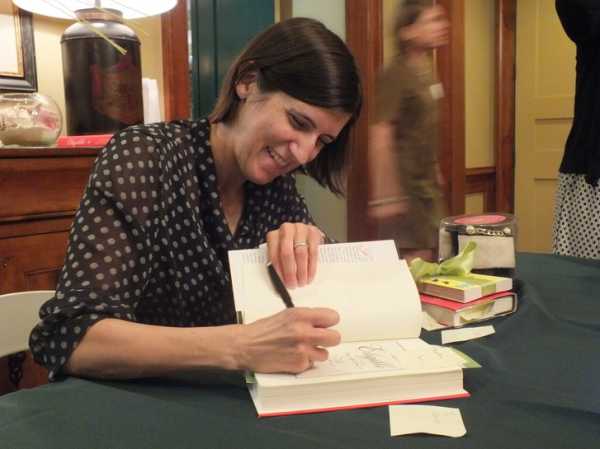
The author at the Princeton Public Library in April, 2016.
Photograph from Princeton Public Library / flickr
The odd part is that I never loved it. The shirt included a kind of necktie I found silly, like the self-conscious women-in-the-workplace clothes of the nineteen-eighties. But the shirt served its purpose and checked off the necessary boxes. If I sweated while standing in front of a podium, it didn’t show. In a suitcase, the shirt didn’t wrinkle. I could wear it in any season. It was adequately professional, or at least implied I’d made a respectful amount of effort. At home, I wear T-shirts and yoga pants or bluejeans, so it felt dressy. Because most of my clothes are black, I was comfortable in it. And the shirt accommodated weight losses and gains. I’m tempted to pretend my weight fluctuated entirely due to my two pregnancies — one of my kids was born in 2009, and the other in 2011 — but it did for other reasons, too, like stress and vanity and Fritos.
I think it was Christmas, 2012, when my two sisters helped me go through my closet and get rid of stuff. I thought they’d laugh when I showed them the shirt, but they both said it was cute. In fact, they said, polka dots were in again.
I bought a few variations on the shirt, but I didn’t like the fit or the patterns as much. Weirdly, even as I became more confident as a writer and as a person, I completely lost faith in my own ability to shop for clothes. In 2013, before the publication of my fourth novel, I met with a stylist at Nordstrom. Since then, I’ve rarely shopped for “event clothes” on my own. I usually do it with my sisters, or a friend; if I’m alone, I take pictures of myself in the dressing room and text them to my sisters.
A lot of times, in a store, clothes appear strange to me, their cuts or flourishes arbitrary. Why is this look stylish now? How long will it be stylish for? It’s slightly embarrassing to admit this—because, as a novelist, I’m supposed to be observant—but I’m flummoxed by the way other women dress. Sometimes I’m literally not even sure how women are dressing. I’ll text my sisters to ask, “Are people still wearing riding boots?” (I know they’re called “riding boots” because a friend told me.)
In my fifth novel, I described a character, a writer for a women’s magazine, wearing “suede caged booties.” I had a vision of the shoes, and I figured out what they were called through a sort of reverse-engineered Google search. I’m not joking when I say that this feat is one of the things about that novel that makes me most proud.
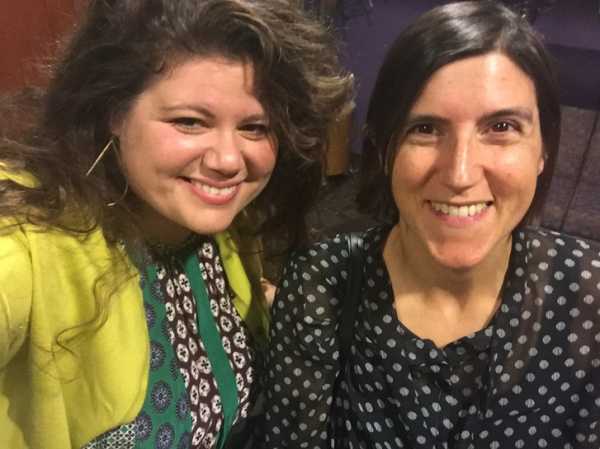
With Rainbow Rowell in Kansas City, 2016.
Photograph courtesy Curtis Sittenfeld

With Margaret Stohl and Rainbow Rowell in Omaha, 2017.
Photograph courtesy Curtis Sittenfeld
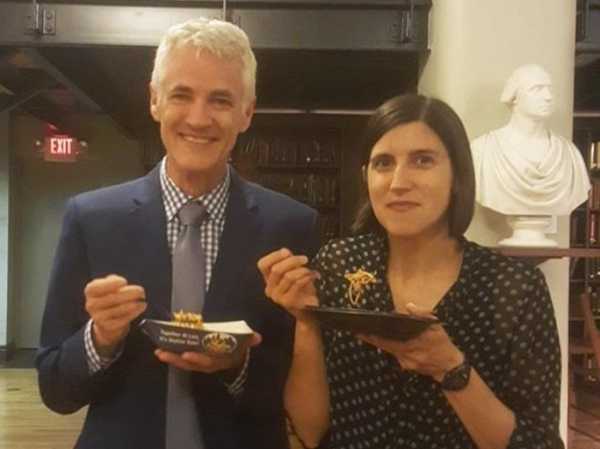
With John Faherty in Cincinnati, 2016.
Photograph courtesy Curtis Sittenfeld
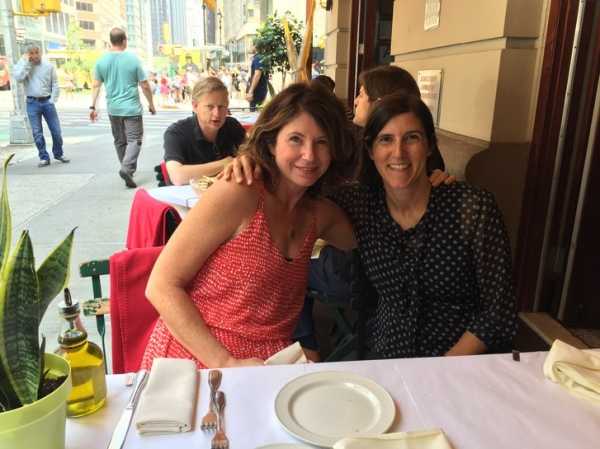
With Paula McClain in Cleveland, 2016.
Photograph courtesy Curtis Sittenfeld
Eventually, I unabashedly embraced wearing the shirt. I think it was a reaction against the pressure created by social media to curate an alluring self-image. I wore the shirt so much that sometimes I appeared in two different places, months apart, with the same other writer, and I was wearing the shirt both times. Naturally, the other writers and I would post pictures of ourselves on Facebook and Twitter.
Who cares? I thought. If a uniform was good enough for Steve Jobs, it’s good enough for me.
In 2015, I tweeted, “I sometimes yearn to write an essay about my H&M blouse from 2004 titled And They Said It Would Never Last.”
In 2016, I tweeted, “Should I acknowledge that I wore the same shirt to almost every event on my book tour or just hope no one noticed?”
And then, in early 2017, I found myself wondering if it was time to retire the shirt. Miraculously, it was in about the same condition it had always been in. I think it’s that I had started to feel like a different person. I was in my forties. My children were no longer babies. Sometimes I couldn’t believe how lucky I was, especially as a writer. Sometimes I felt very sad.
A close friend of mine named Sam, a fellow-writer with whom I’d attended college, was being treated for stomach cancer during this time. Sam died on April 1, 2017. I decided I’d wear the shirt to Sam’s memorial service in Los Angeles, then I’d never wear it again. But the weekend of the service one of my kids got really sick, and I stayed at home in St. Louis. I felt awful about it.

With Sam Park, 2017.
Photograph courtesy Curtis Sittenfeld
I haven’t worn the shirt since Sam died, though it continues to hang in my closet. Meanwhile, in my head, I can still hear Sam’s voice. I think about the things I’d like to tell him, and I imagine what he’d say in reply. This isn’t the same as if we were having a real conversation.
My choice to stop wearing the shirt feels logical, an absence that echoes, in its own small and inanimate way, the absence of Sam. But the choice might have a less poetic explanation, which is that I think I happened to wear the shirt the day Sam died. I learned of his death via text, while I was at the grocery store. That night, my husband and I were scheduled to eat dinner at a restaurant with another couple we liked but didn’t know well. We went ahead with the dinner, and I didn’t mention Sam.
Recently, I asked my husband if he remembers whether I had on the shirt that night, and he said he doesn’t. Then I asked if he thinks it’s strange that I haven't worn it since Sam died. He said no. “There’s so much you can’t control,” he said. “But you can control what you wear.”
Samuel Park’s novel “The Caregiver” will be published in September.
Sourse: newyorker.com

